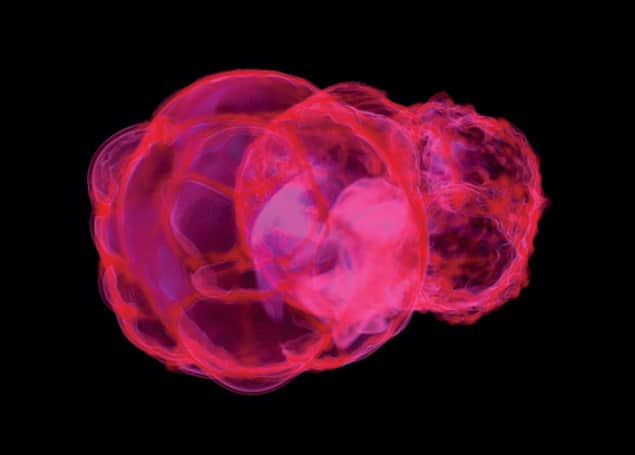
The locations and timing of the closest supernovae to Earth, which took place within the last few million years, could be determined thanks to new studies of a specific isotope of iron. The research, carried out by two independent teams, suggests that two supernovae exploded within 330 light-years of Earth in the past 2.3 million years. The findings – which combine “deep-sea astronomy” with “galactic archeology” – hint at the possibility that the supernovae may have affected Earth’s climate, leading to the Pleistocene geological epoch from which homo sapiens evolved.
Astronomers have long suspected that supernovae taking place in our galactic neighbourhood could have decided effects on our planet, possibly causing mass extinctions or global climate changes. Iron-60 (60Fe) is produced when a supernova explodes, and its presence in the Earth’s deep-sea crust means that one or more supernovae have occurred within the last few million years.
Interstellar iron
Now, two individual teams led by Dieter Breitschwerdt at the Berlin Institute of Technology, and Anton Wallner of the Australian National University, have looked at the links between these 60Fe deposits and supernovae. When sampling sediments at the bottom of the Atlantic, Pacific and Indian oceans, Wallner’s team used accelerator mass spectrometry to measure an overabundance of 60Fe, relative to normal terrestrial iron, 40 times greater than the background level. The 60Fe dates back to two time periods – 1.5 to 3.2 million years ago and 6.5 to 8.7 million years ago. This abundance is far higher than could be explained by meteoric debris or the impact of a large asteroid, leaving only one other alternative: supernovae.
Breitschwerdt believes that it may be possible to tell when and where the more recent of these supernovae took place. Our solar system resides within an enormous cavity within the interstellar medium known as the “Local Bubble”. Some 300 light-years wide, “the very existence of the Local Bubble requires supernovae explosions in the solar neighbourhood to have blown it out” says Breitschwerdt.
The team calculated the most probable trajectories and masses of the massive stars that could have become supernovae, and hit upon a group of local stars known as the Scorpius–Centaurus Association. The researchers found that an 8.8 solar-mass star could have exploded relatively close to Earth 2.3 million years ago, followed by a 9.2 solar-mass star just 1.5 million years ago. Together, these two supernovae contributed 47% of the 60Fe found in the Earth’s crust. Another dozen or so stars in the cluster also exploded earlier, but the longer ago they occurred, the further away they were, lessening their impact on the Earth.
“Both our publication and Breitschwerdt’s complement each other, and I think we now have a very nice and consistent picture through ‘deep-sea astronomy’ and galactic archaeology,” says Wallner.
Cosmic catastrophe?
But there may be another twist in the tale. Around 2.6 million years ago, the Earth entered a period of repeated glaciations known as the Pleistocene epoch. When it ended 11,700 years ago, human beings emerged as the dominant form of life on the planet. The start of the Pleistocene coincides with the onset of the Scorpius–Centaurus supernovae. Could they be related?
Although there is no direct evidence and the timing may merely be coincidental, Adrian Melott of the University of Kansas thinks it might be worth investigating. “One idea is that cosmic rays from supernovae can cause cloud formations that might have cooled the planet,” he says. “We can certainly model the cosmic rays, but the cloud cover is more difficult because that’s a more speculative line of research.”
Both Wallner and Breitschwerdt agree that this is a reasonable proposition. “It might be that there is a similar coincidence for the older 60Fe flux seven to eight million years ago, although not as pronounced,” says Wallner, adding that the idea is still “very speculative, and I think most Earth scientists are sceptical”. While these supernovae were too far away to irradiate the planet and cause mass extinctions, Melott considers them a proof of concept. “The take-home message is that supernovae can happen nearby,” he says. “Over the past 500 million years there must have been supernovae very nearby with disastrous consequences. There have been a lot of mass extinctions, but at this point we don’t have enough information to tease out the role of supernovae in them.”
Both Breitschwerdt’s paper and Wallner’s paper are published in Nature.



